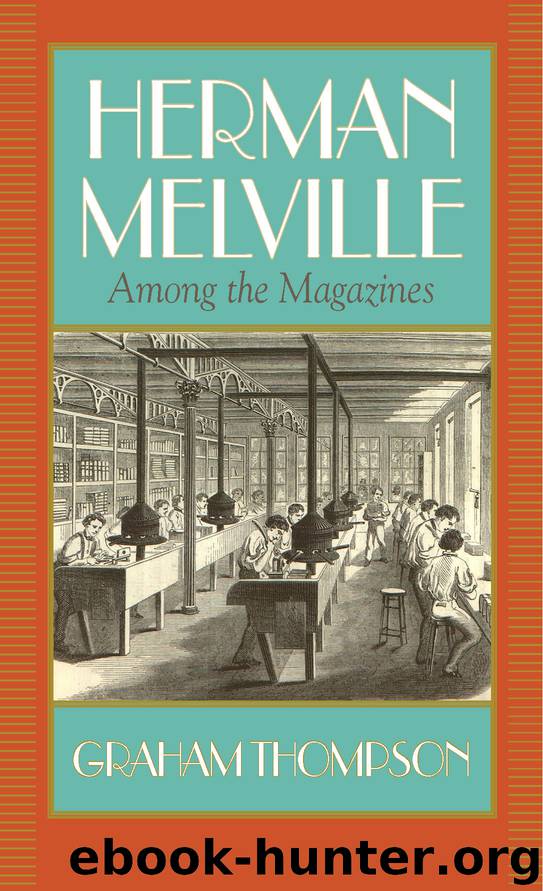Herman Melville: Among the Magazines by Graham Thompson

Author:Graham Thompson
Language: eng
Format: epub
Tags: LIT004020 Literary Criticism / American / General, American, General, Books & Reading, Literary Criticism, LIT007000 Literary Criticism / Books & Reading
Publisher: University of Massachusetts Press
Published: 2018-01-15T00:46:27.500000+00:00
4
The “Unbounded Treasures” of Magazine Paratexts
Reading Melville’s magazine writing as pioneer readers once read it in the 1850s is no longer possible. Contemporary critics cannot recreate, for want of resources, how those readers chanced upon anonymous stories in Putnam’s and Harper’s and skimmed, dismissed, or perhaps even reread them in the drawing room, the railway carriage, or the library. The opinions of professional reviewers of The Piazza Tales are poor substitutes; like us, they could never not know they were reading Melville. The book cover and the contents page of whatever edition we present-day Melville readers hold in our hands remind us that we are trapped in what psychologists call ironic processing: try not to think about Melville’s authorship when reading “Bartleby, the Scrivener” or “Benito Cereno” and all one sees is Rodney H. Dewey’s 1861 photograph, from which Melville stares back defiantly, arms folded, hands withdrawn.
This chapter offers alternative speculations on how to cope with this dilemma rather than a solution to it. Primarily I concentrate on the one thing a contemporary reader can do: read Melville’s work as magazine writing by also reading the other material among which it was embedded when first published. The different magazine pieces that appeared in Putnam’s or Harper’s may not have been written in dialogue with one another, but for the reader they were all part of her or his experience of the magazine; they were the paratextual apparatus readers often take for granted—titles, subtitles, prefaces, epigraphs, illustrations, book covers, blurbs, dust jackets, and so on—that in Gérard Genette’s words “surround” and “extend” a text “to ensure the text’s presence in the world.”1 While magazines exhibit many of the same paratextual components one finds in books and book publishing, they also have their own paratextual systems.
A magazine is most like an edited book that contains pieces by different authors, but unlike an edited book, because it has a title—Putnam’s Monthly Magazine of American Literature, Science and Art, for instance—that reappears periodically with new sections written by sometimes the same but also different authors. One reason why Putnam’s was not a book in the 1850s was because it paginated continuously—six issues to a volume—and printed two columns to the page rather than one. Each article published within an issue one might consider a text, but each issue of Putnam’s is also a text formally sealed by front and rear covers. And the collection of six issues into a volume creates another text when that volume is bound and published in book format. Genette describes paratextuality as “first and foremost a treasure trove of questions without answers.”2 The first questions one might ask of magazine paratexts are: What exactly constitutes a magazine text? Where exactly does a magazine text begin and end? And how viable is it to think of Melville’s magazine pieces as self-sufficient texts one can extract from the pages of Putnam’s and Harper’s without fundamentally altering their constitution?
The textual boundaries of magazine writing are not immediately obvious. Consider the example of Melville’s “The Encantadas.
Download
This site does not store any files on its server. We only index and link to content provided by other sites. Please contact the content providers to delete copyright contents if any and email us, we'll remove relevant links or contents immediately.
| African | Asian |
| Australian & Oceanian | Canadian |
| Caribbean & Latin American | European |
| Jewish | Middle Eastern |
| Russian | United States |
4 3 2 1: A Novel by Paul Auster(12289)
The handmaid's tale by Margaret Atwood(7681)
Giovanni's Room by James Baldwin(7197)
Asking the Right Questions: A Guide to Critical Thinking by M. Neil Browne & Stuart M. Keeley(5650)
Big Magic: Creative Living Beyond Fear by Elizabeth Gilbert(5615)
Ego Is the Enemy by Ryan Holiday(5297)
The Body: A Guide for Occupants by Bill Bryson(4976)
On Writing A Memoir of the Craft by Stephen King(4864)
Ken Follett - World without end by Ken Follett(4646)
Adulting by Kelly Williams Brown(4488)
Bluets by Maggie Nelson(4477)
Eat That Frog! by Brian Tracy(4437)
Guilty Pleasures by Laurell K Hamilton(4362)
The Poetry of Pablo Neruda by Pablo Neruda(4041)
Alive: The Story of the Andes Survivors by Piers Paul Read(3970)
White Noise - A Novel by Don DeLillo(3955)
Fingerprints of the Gods by Graham Hancock(3943)
The Book of Joy by Dalai Lama(3903)
The Bookshop by Penelope Fitzgerald(3780)
